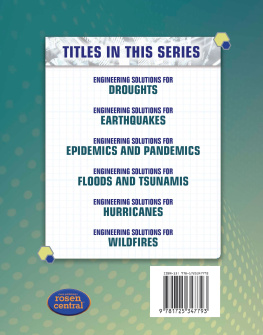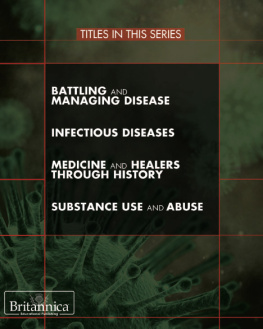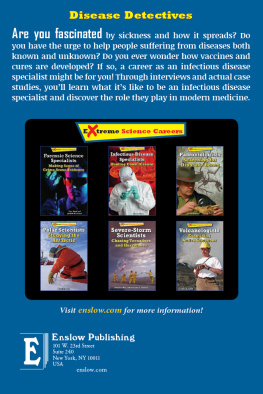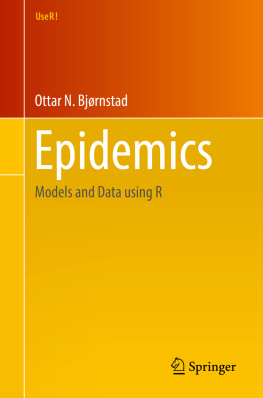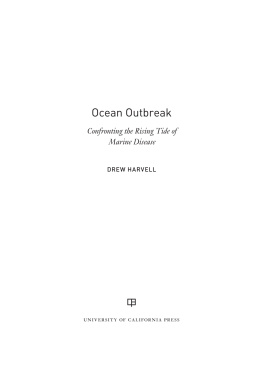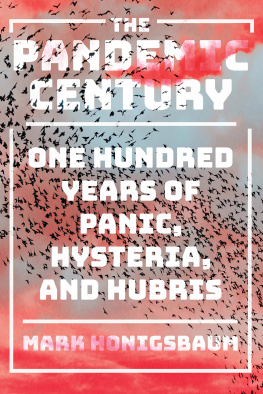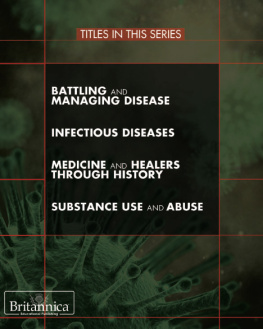
Published in 2020 by The Rosen Publishing Group, Inc.
29 East 21st Street, New York, NY 10010
Copyright 2020 by The Rosen Publishing Group, Inc.
First Edition
All rights reserved. No part of this book may be reproduced in any form without permission in writing from the publisher, except by a reviewer.
Library of Congress Cataloging-in-Publication Data
Names: Rogers, Kara, author. Title: Engineering solutions for epidemics and pandemics / Kara Rogers.
Description: First edition. | New York: Rosen Publishing, 2020. | Series: Preparing for disaster | Audience: Grades 5 to 8 | Includes bibliographical references and index.
Identifiers: LCCN 2019008487! ISBN 9781725347793 (library bound) I ISBN 9781725347786 (pbk.)
Subjects: LCSH: EpidemicsPreventionJuvenile literature. I Disaster medicineJuvenile literature. I Emerging infectious diseasesJuvenile literature. I Emergency managementJuvenile literature. I Communicable diseasesPreventionJuvenile literature. I World healthForecastingJuvenile literature. Classification: LCC RA653.5 .R64 2020 I DDC 614.4dc23 LC record available at https://lccn.loc.gov/2019008487
Manufactured in the United States of America
CONTENTS
Introduction
T hroughout history, outbreaks of disease, in which an illness appears suddenly in a community, have had a strong effect on humans. The illness often is contagious, meaning that it is easily spread from one person to another. Outbreaks quickly can become widespread. They affect many people and can develop into an epidemic. If the disease continues to spread through a country or expands to other parts of the world, the outbreak becomes known as a pandemic.
Although many people may become sick because of an epidemic or a pandemic, many of these outbreaks claim very few lives. There are some diseases, however, that are more dangerous. They cause many people to become severely ill and result in many deaths as they spread through communities. Historically, outbreaks of disease often caused hundreds or even thousands of deaths. Outbreaks usually lasted two or three years, with the disease appearing again in nearby places. One of the deadliest outbreaks in modern history was the influenza pandemic of 1918 to 1919, also known as the Spanish influenza pandemic. This pandemic caused about twenty-five million deaths.
Its frightening to imagine a rapidly spreading sickness that could cause death. But medical professionals, health workers, scientists, and emergency responders are prepared. These different groups of experts carefully plan ahead. They make use of science, technology, engineering, and mathematics (STEM). They bring together tools, resources, and experience. Resources and tools include vaccines, medicines, and other approaches to treating and preventing illness. These experts know a lot about disease and how to stop people from becoming sick. They also have the skills they need to get along and share ideas with others. In this way, emergency responders, medical workers, and even individuals can work together to limit or prevent outbreaks.

A researcher works with dangerous viruses in a laboratory. Some viruses cause deadly diseases that can spread rapidly.
CHAPTER ONE
Killer Diseases
E very year, human societies are attacked by outbreaks of disease. Long ago, people believed such outbreaks were the result of supernatural forces, such as the anger of God. Later, people blamed them on miasma, or bad air. Some people believed that by just breathing this air, they would fall ill. With the discovery in the nineteenth century of infectious microorganismsvery tiny living things that can be seen only with a microscopea scientific understanding of disease formed. Knowing how diseases surface, how they progress, and how they can be stopped is critical to engineering solutions to epidemics and pandemics.
Diseases That Raise the Alarm
Different diseases have the ability to appear suddenly and affect many people. Some are more likely to give rise to epidemics and pandemics. Of these, there are about fifteen to twenty that experts are most concerned about. One of these is influenza, which many people simply refer to as the flu. Different types of flu move through groups of humans and animals, and every now and then new types appear. Avian influenza, for example, used to be found only in birds like chickens and ducks. But in the late twentieth century, it also began to infect humans. Avian influenza causes cough, fever, headache, sore muscles, and sore throat. These symptoms are almost identical to regular flu, but avian influenza is much worse and deadlier.

A doctor treats a patient who has been infected with cholera at a hospital in Sanaa, Yemen. Cholera causes extreme diarrhea that results in a potentially dangerous loss of water from the body.
Another disease that causes epidemics in humans is cholera. Cholera affects a part of the body called the small intestine. It causes extreme diarrhea that leads to a harmful loss of water from the body. This condition, known as dehydration, can result in death. Outbreaks of cholera have been a major concern since the 1800s. At that time, thousands of people died from cholera in places like India, Thailand, and Indonesia. It later spread to Europe and the Americas. The twenty-first century is witness to what experts call the seventh pandemic of cholera. Between 2011 and 2017, the disease caused 308 separate outbreaks. During that same time, the next two leading epidemics were of meningitis and an illness called Zika virus disease. Meningitis is caused by microscopic organisms known as bacteria. It can be a life-threatening disease. It affects the meninges, the thin membranes that cover the brain and spinal cord. Like cholera, it began to affect large numbers of people in the 1800s. The first outbreaks of meningitis took place in Europe, North America, and Africa.
Other diseases that cause epidemics include yellow fever, chickungunya fever, and West Nile fever. All three of these diseases cause fever and flu-like illness. Humans can catch these diseases from mosquitoes. Plague, shigellosis, typhoid fever, and Ebola are other important causes of epidemics. Ebola virus disease is especially alarming in humans. It spreads easily and has a high fatality rate, causing many people who catch it to die. The largest Ebola outbreak took place in 2014 to 2015 in western Africa. It mainly struck people in Guinea, Sierra Leone, and Liberia. More than 28,600 cases and 11,300 deaths were recorded by the World Health Organization (WHO).

A health worker wears protective equipment while offering a drink to a young Ebola patient in Sierra Leone in 2014. Africa experienced one of the worst Ebola outbreaks in history in 2014 and 2015.
Deadly Agents
The diseases that give rise to epidemics and pandemics typically are caused by microscopic agents, or pathogens, that infect the body. For this reason, these diseases commonly are described by the term infectious disease. Pathogens include bacteria, fungi, helminths (worms), protozoa, and viruses. Of these, bacteria and viruses are the most common causes.
Epidemic Versus Pandemic: Whats the Difference
Next page
